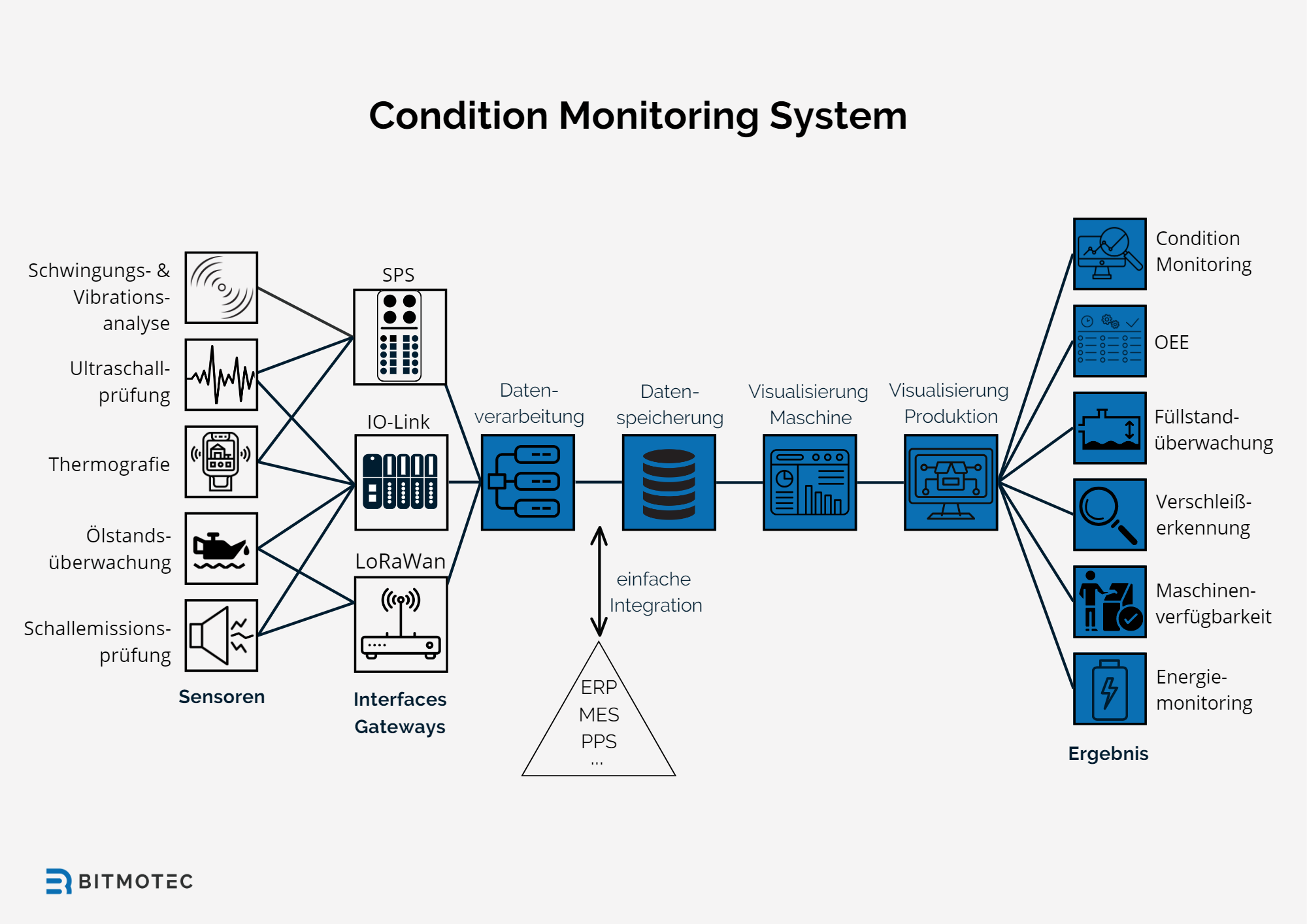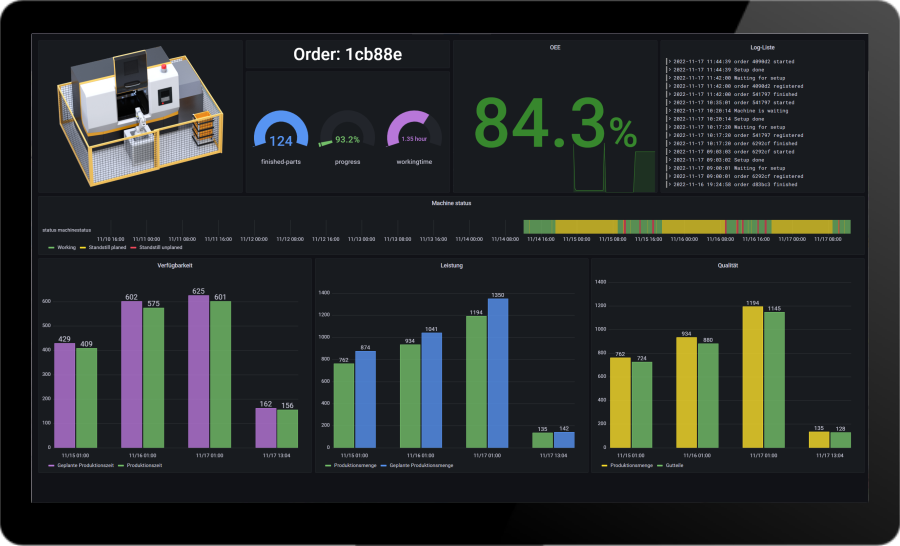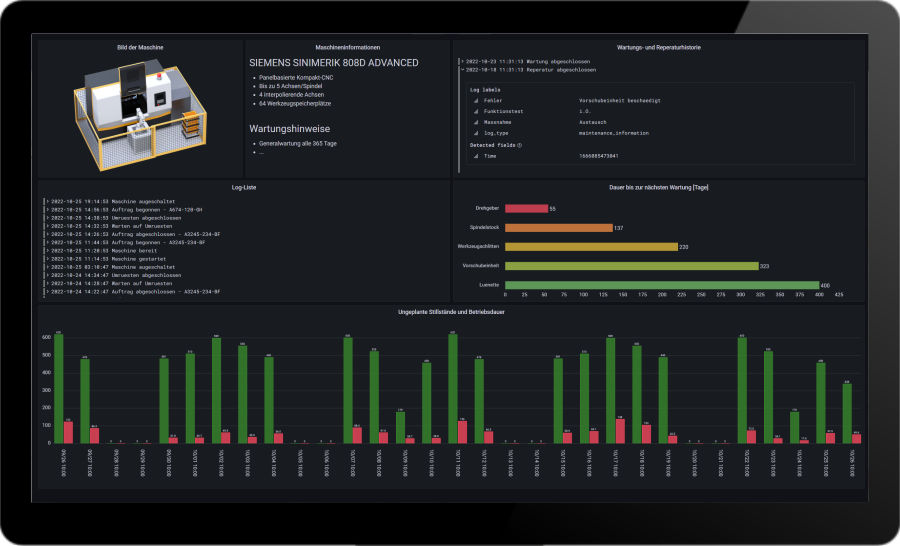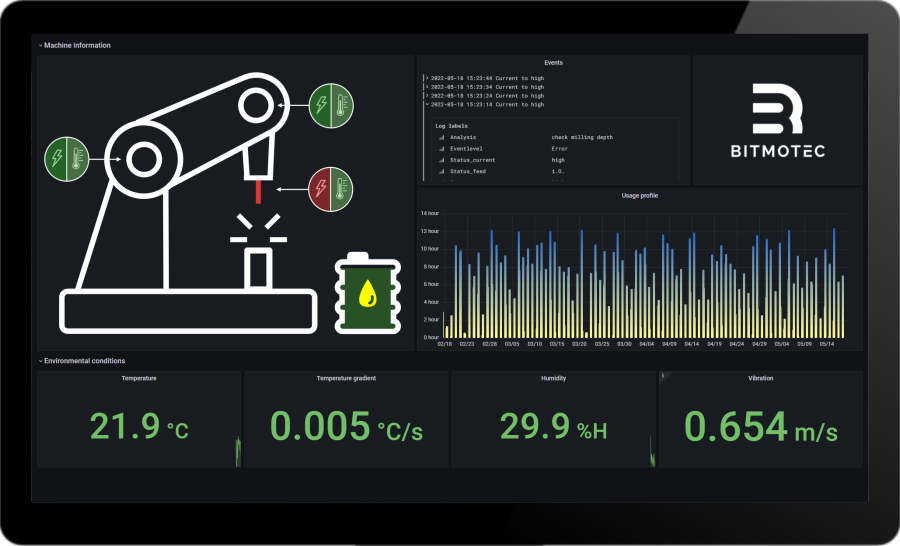Condition Monitoring Software and Tools
Importance of Condition Monitoring Software and Tools
Condition monitoring software and tools play a crucial role in the monitoring of machines and systems. Meanwhile, the process of condition monitoring is becoming increasingly important: companies minimize costs and downtimes by counteracting unnecessary failures of machines and systems at an early stage. The use of condition monitoring software and tools also makes it possible to monitor the condition of machines and systems in real time and to react to deviations and anomalies at an early stage. In this way, maintenance and repairs can be optimally planned and carried out even before costly failures occur. Condition monitoring software and tools are able to process and analyze particularly large amounts of data in real time. The use of algorithms and machine learning allows anomalies and deviations to be detected at an early stage.
Fundamentals of Condition Monitoring
Condition monitoring is a process for monitoring the condition of machines and systems in real time. The main goal is to detect and avoid failures at an early stage in order to minimize costs and downtimes. Various techniques and methods are used. Companies can collect data and then analyze it to monitor the health of machinery and equipment.
Applications
Condition monitoring includes various aspects, such as the monitoring of operating parameters, the analysis of sensor and machine data, the creation of maintenance plans and the execution of repairs and maintenance measures.
Advantages
The most important advantages of condition monitoring are higher availability of machines and systems, a longer service life of systems, higher safety for employees and lower maintenance costs. By monitoring the condition of machinery and equipment, companies can react to potential problems at an early stage and also avoid expensive downtime and repair costs.
Implementation
However, the implementation of condition monitoring requires careful planning and implementation. Companies need to make sure they have the right tools and resources in place to make the process a success. Close collaboration between the IT and operations teams is also required to identify the right data sources and analyze the data effectively.
Techniques and Methods in Condition Monitoring
There are various techniques and methods that support companies in carrying out condition monitoring. The following is an overview of the nine most important techniques:
- Oil analysis
- Vibration analysis
- Motor Circuit Analysis
- Thermography
- Ultrasonic monitoring
- Radiography
- Laser interferometry
- Electrical monitoring
- Electromagnetic Measurement
The most important applications
Each technology has its own application and is therefore suitable for certain types of machines and systems. The following is just a brief overview of the most important application of each technique:
Oil analysis
Oil analysis is a method of monitoring the condition of oils used in machinery and equipment. The analysis of oil samples makes it possible to identify deviations in the composition of the oil, which can therefore indicate problems in the machine.
Vibration analysis
Vibration analysis is a method of monitoring the vibrations of machines and equipment. By analysing the vibrations, it is possible to detect deviations in the operation of the machine, which can indicate possible problems.
Motor Circuit Analysis
Motor circuit analysis is a method of monitoring the electric current flowing through motors. By analyzing the current, it is possible to detect deviations in the operation of the motor, which can indicate possible problems.
Thermography
Thermography is a method of monitoring the temperatures of machines and systems. By analysing temperature differences, it is possible to detect deviations in the operation of the machine, which can indicate possible problems.
Ultrasonic monitoring
Ultrasonic monitoring is a method of monitoring noise generated by machinery and equipment. By analysing the noise, it is possible to detect deviations in the operation of the machine, which can indicate possible problems.
Radiography
Radiography is a method of monitoring metals in machinery and equipment. Thus, by analysing X-rays, it is possible to detect deviations in the composition of the metal, which can indicate possible problems.
Laser interferometry
Laser interferometry is a method for monitoring vibrations of machines and systems. By analyzing interference patterns from laser beams, it is possible to detect deviations in the operation of the machine, which can indicate possible problems.
Electrical monitoring
Electrical monitoring is a method of monitoring electrical signals in machinery and equipment. By analysing electrical signals, it is possible to detect deviations in the operation of the machine, which can indicate possible problems.
Electromagnetic Measurement
Electromagnetic measurement is a method of monitoring electromagnetic fields in machinery and equipment. By analysing electromagnetic fields, it is possible to detect deviations in the operation of the machine, which can indicate possible problems.

Software & Tools
Condition monitoring software and tools are crucial to effectively monitor machinery and equipment . The following are some of the most important software and tool components of a condition monitoring system:
- Data acquisition: Acquisition of data from sensors and machines
- Data processing: Processing and analysis of data
- Data visualization: Presentation of data in an easy-to-interpret form
- Alerting: Notification of anomalies and deviations
- Maintenance planning: Planning of maintenance and repair measures


Benefits of Condition Monitoring Software and Tools
Condition monitoring software and tools offer a number of advantages for the operation of machines and systems. Here are a few examples that are relevant for companies:
Intelligent condition monitoring of technical systems
By using condition monitoring software and tools, companies can monitor the condition of machinery and equipment in real-time. As a result, deviations and anomalies can be detected early before costly failures occur. Thanks to intelligent condition monitoring, companies are thus able to optimize maintenance schedules and thus carry out repairs in a timely manner.
Early Warning Systems and Predictive Maintenance
Condition monitoring software and tools enable companies to implement early warning systems and predictive maintenance strategies. By using algorithms and machine learning, companies can detect potential failures early and plan and carry out maintenance and repair actions before an outage occurs. As a result, companies can reduce downtime and extend the life of machinery and equipment.
Advantages of Condition Monitoring
The advantages of condition monitoring are manifold. By monitoring machinery and equipment , companies can optimize maintenance schedules and improve efficiency. As a result, costs and downtime can be minimized. The use of condition monitoring software and tools also allows companies to increase the safety of employees by avoiding dangerous situations. By using condition monitoring, companies can also reduce their environmental impact, as they are able to reduce energy consumption and emissions.
Challenges and solutions in condition monitoring
Condition monitoring offers many advantages as well as challenges in implementation. Here are some of the key challenges and solutions of condition monitoring:
Challenges in Condition Monitoring
- Initially high costs: The implementation of condition monitoring can initially cause high costs, especially when it comes to investing in sensors, software and infrastructure, for example.
- Data integration: Condition monitoring requires the integration of data from different sources. This can be challenging, as the compatibility of data formats and protocols can be more or less extensive.
- Data volume: The monitoring of machines and systems generates large amounts of data. As a result, their processing, storage and analysis can tie up resources and time.
- Complexity: Condition monitoring requires special knowledge and skills. In order for companies to be able to analyze the data effectively and take action accordingly, it requires expert knowledge as well as training and further education of employees.
Choosing the right tools for the job
After all, choosing the right tools and software is crucial for success in the use of condition monitoring. Companies also need to ensure they have the right tools in place to collect, process, and analyze the data effectively. They should also pay attention to user-friendliness and compatibility with other systems. It’s also important to ensure that the tools are scalable and can grow with the needs of the business.
Result
Condition monitoring is an important method for monitoring machines and systems, which enables companies to detect problems in everyday production at an early stage and thus minimize failures. The use of condition monitoring software and tools makes it possible to implement intelligent condition monitoring and predictive maintenance strategies. As a result, companies improve efficiency and minimize downtime.
Although there are challenges in implementing condition monitoring, companies can successfully address them with solutions such as the SKF methodology and selecting the right tools and software. By implementing condition monitoring, companies can not only improve efficiency and minimize downtime, but also increase employee safety and reduce environmental impact.
In today’s world, not only in view of the rapidly developing Industry 4.0, it seems all the more relevant that companies recognize the importance of condition monitoring and consider its implementation as part of their overall operational strategy. With the right approach and support, companies can reap the benefits of condition monitoring and be successful in the long term.

